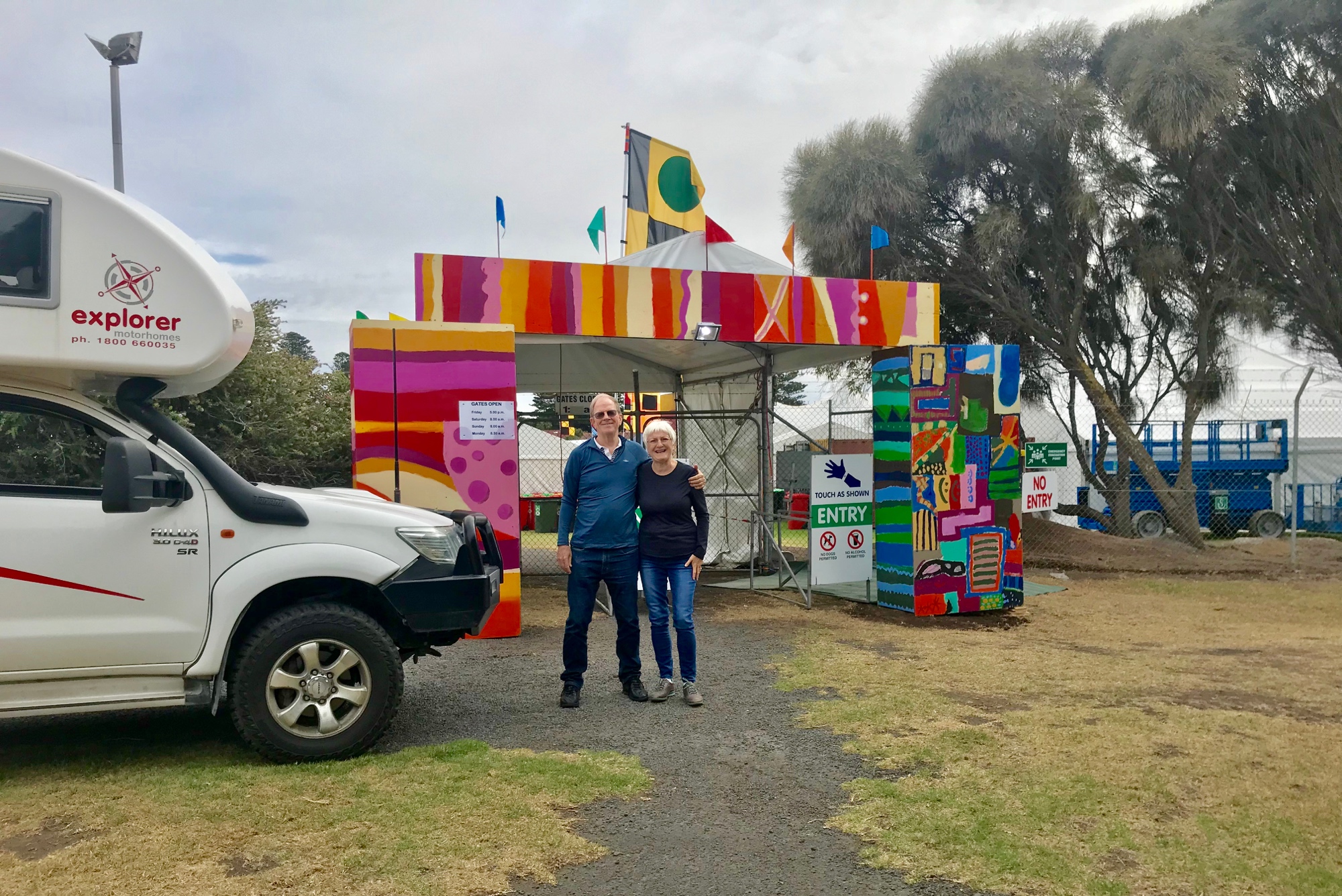During our month travelling in Victoria we visited three music festivals and caught up with friends in Melbourne as discussed in the previous blog. In addition March was a good time for exploring various parts of that state. We saw lots of beautiful country and interesting artwork. Just past the end of the Great Ocean Road is equally as scenic coastline with the added benefit of ‘no people’ around.


This map shows our route through Victoria with festival locations highlighted in purple and campsites highlighted in blue.

After leaving Port Fairy/Warrnambool we headed north to the Grampians National Park for some hiking. First stop was the quiet little town of Dunkeld which boasts one of the best dining destinations in Australia, the Royal Mail Hotel. So of course, we had lunch there and also collected all the Grampians hiking brochures at the Tourist Info Centre. At Halls Gap we visited Brambuk, the national park info and cultural centre. It was quite sobering going through the aboriginal museum; seeing the photos and reading the stories of aboriginal history in the area.

The first evening in Halls Gap we visited our friends, Phil and Monica (who we met travelling in 2017). They have a large property and offered us a park at their place. We all went out to dinner at the local Indian restaurant. They are intrepid walkers (and founders of Auswalk, a guided walk company) so in the morning we sat down with them and got the lowdown on the Grampians, in terms of which walks and drives to do. We also got a tour of their amazing vegie garden – figs, avocados, raspberries, tomatoes, spring onions, pumpkins, squash plus lots more. We came away with a generous collection! They were very hospitable!
 Phil and Monica’s place with the vegie garden on the left hand side.
Phil and Monica’s place with the vegie garden on the left hand side.
We then started our walking with a 2.5 hr, 7.5 km(return) hike to MacKenzie Falls. Nice walk and sunny day, but I had a bad trip crossing on some stepping stones; was a bit shaken and got some nice bruises. Spent the night in a quiet NP campground.


Decided to combine driving and short scenic walks to give ourselves an easier day. Visited four lookouts for a total of 5 kms of walking and some awesome views. Spent the night in another NP campground, Stapylton, and finished the day with a walk to some aboriginal art.



Tackled the steep, hard walk up Mt Stapylton (278 m elevation change). Although it was only 4.6 kms, we found it quite tough and did not go the last little bit to the top as it was very exposed, steep and no one else was around. Between the walk and the 29C temperature, we were both tired, so later did an easy walk to more aboriginal art and then checked into a caravan park in Halls Gap, where we enjoyed a nice shower.




More walks followed, more great lookouts and we returned to Phil and Monica’s for another night, which turned into another two nights as Dick spent a day working with Monica on a couple of technology projects. We had a nice social time and enjoyed two very nice dinners.


Eventually we did leave their place, laden with fresh figs and tomatoes from their garden, and then we did the iconic Grampians walk, The Grand Canyon and the Pinnacles. Quite a strenuous walk with a 280 meter elevation change on a hot day. Took us 3.5 hours to do the 4 km return trip. More stunnning views!!! Before we left the Grampians we headed back south to Dunkeld, treated ourselves to another meal at the Royal Mail Hotel, a free shower at the tourist info and found a nice free camp. Our last walk was the Picaninny hike (2.4kms) before we drove to the Manja Shelter to view another aboriginal art site, and then moved on to a caravan park in the town of Dimboola prior to booking into the Horsham Country Music Festival.





In the Horsham area we saw The Pink Lake, Little Desert NP, Mt Arapiles (which is a large rock pile) and The Stick Shed (#101 on the National Heritage List). It was built in 1941 to store wheat during World War II and is an impressive & unusual example of Australian rural architecture (bush ingenuity & adaptation), which used 560 unmilled hardwood poles ensuring the structure could move and shift in high winds.


We’d heard about ‘The Silo Art Trail’ and had a good day driving the 200+kms through six small towns in the Wimmera Mallee region. The silo murals were painted by renowned artists who spent time in each region before using their art to tell a unique story about each town. A great initiative and worth seeing, although there wasn’t much done in each place to encourage you to stay more than the five minutes it took to view the silos.





We finished that silo day at Swan Hill and started our Murray River time by taking in their light and laser show called ‘ Heartbeat of the Murray’.

Aiming to do some free camping along the Murray River we left Swan Hill (after photographing The Big Cod), visited the Ibis Rookery at Middle Lake (no Ibis but saw ducks and pelicans from the hide), and found an isolated campsite on Gunbower Creek in the forest on Gunbower Island (nr Koondruk). Our next camp was further along the Murray near Echuca. We spent some time in Echuca doing a tour at the Wharf Discovery Centre. It was very good explaining the interesting history of Echuca and the Murray/Darling River system. Having got the silo bug we drove to Rochester to see their painted silo and town murals before crossing over the Murray into NSW for our final free camp along the Murray River.





















